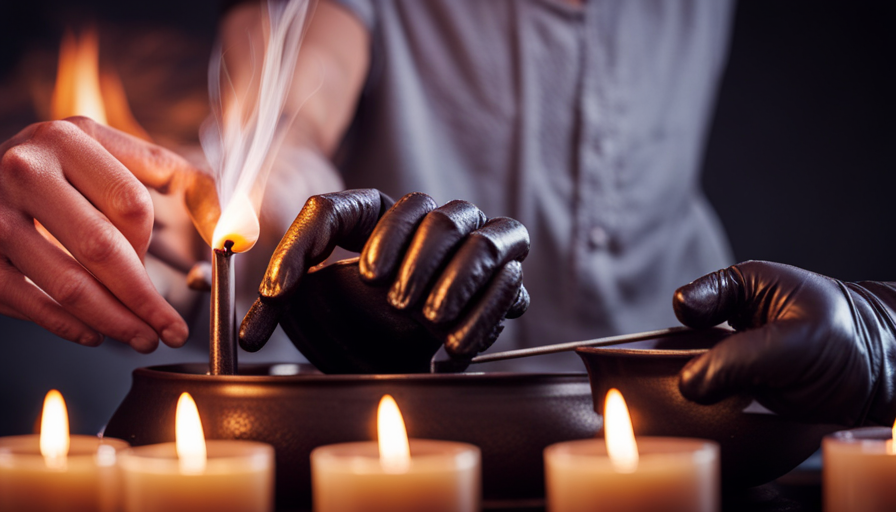Have you ever eagerly lit a candle, anticipating the amazing scent that is meant to fill the room, only to be disappointed and wonder, “Why can’t I smell my candle?”
It’s like a symphony without its crescendo, a beautiful painting without its vibrant colors. The experience falls flat, leaving you yearning for the captivating scents that candles are known for.
There are several factors that can contribute to this olfactory letdown. The quality of the candle plays a significant role, as does its placement in the room.
The size of the room itself, along with sensory adaptation, can also affect your perception of the scent. Additionally, the maintenance of the wick, burn time and temperature, air circulation, and even the strength and type of scent can all contribute to the lackluster experience.
In this article, we will delve into the reasons behind your candle conundrum, exploring each factor in detail. By understanding these variables, you will be equipped to create an aromatic ambiance that truly delights the senses.
So, let’s embark on a journey to unravel the mysteries of why you can’t smell your candle and rediscover the joy of filling your space with delightful fragrances.
Key Takeaways
- The quality and ingredients of the candle, such as the fragrance oils and wax used, can affect the strength of the scent.
- Proper placement of the candle in the room, considering factors like room size and avoiding drafts or air vents, can enhance the scent experience.
- Sensory adaptation can make it harder to detect the scent over time, so taking breaks, sniffing coffee beans, or changing the location of the candle can help.
- Factors like wick maintenance, burn time and temperature, air circulation, and the strength and type of scent can all influence the release and spread of the candle’s fragrance.
Quality of the Candle
The candle’s poor quality is why I can’t smell it. When it comes to candle fragrance, the quality and composition of the candle itself play a crucial role.
A high-quality candle is made with a blend of premium fragrance oils that are carefully selected to create a pleasant and long-lasting scent. On the other hand, a low-quality candle may contain lower grade fragrance oils or even synthetic fragrances, resulting in a weaker scent that is difficult to detect.
Additionally, the ingredients used in the candle can affect its fragrance. Natural wax, such as soy or beeswax, tends to hold and release fragrance better than candles made with paraffin wax. Paraffin wax candles can have a stronger scent initially, but it may fade quickly. The quality of the wick is also important, as a properly sized and centered wick ensures an even burn and optimal fragrance release.
The quality of the candle and its ingredients greatly impact the fragrance it emits. A candle with poor quality fragrance oils or low-grade ingredients may result in a weaker scent that is hard to detect.
Now, let’s explore how the placement of the candle can also affect its aroma.
Candle Placement
Positioning your candle in the right spot enhances the fragrance experience. The scent of a candle can be affected by its placement in a room. To fully enjoy the candle fragrance, it’s important to consider the room temperature and the position of the candle within the space.
Firstly, room temperature plays a crucial role in scent diffusion. If the room is too cold, the fragrance molecules may not evaporate properly, resulting in a weaker scent. On the other hand, if the room is too warm, the fragrance may evaporate too quickly, leading to a shorter-lasting scent. It’s best to keep the room temperature at a comfortable level to allow the candle to release its full aroma.
Additionally, the position of the candle within the room can impact the scent. Placing the candle in a central location will allow the fragrance to disperse more evenly throughout the space. Avoid placing the candle near drafts or air vents, as this can cause the scent to dissipate more quickly.
Now, let’s move on to the next aspect of creating a delightful fragrance experience: the size of the room.
Size of the Room
Although it may seem challenging, adjusting the candle placement according to the size of the room can significantly enhance the fragrance experience.
When it comes to room decor, the size of the room plays a crucial role in how well you can smell your candle. In a small room, such as a bathroom or a cozy reading nook, placing the candle near you will allow the fragrance to envelop the space and create a more intimate ambiance. On the other hand, in a larger room, like a living room or a bedroom, it’s important to strategically place the candle in a central location. This will ensure that the fragrance spreads evenly throughout the room, creating a pleasant and inviting atmosphere.
The size of the room also affects how strong or subtle the candle fragrance will be. In a smaller room, the scent will be more concentrated, making it easier to detect and enjoy. In a larger room, the fragrance may be more subtle, requiring you to place the candle closer to where you spend most of your time.
Understanding the relationship between room size and candle placement is essential for optimizing your fragrance experience. By adjusting the candle placement according to the size of the room, you can fully enjoy the delightful scents and create a cozy atmosphere that complements your room decor. However, even with the perfect placement, our sense of smell can sometimes become accustomed to the fragrance over time, leading to a decreased ability to detect the scent.
Sensory Adaptation
To fully appreciate the aromatic experience, you must be aware that your senses can gradually become less sensitive to the fragrance over time. This is known as sensory adaptation, a natural process that allows our bodies to adjust to constant stimuli.
When we are exposed to a particular scent for an extended period, our olfactory receptors become less responsive, making it harder to detect the aroma. However, there are ways to enhance olfactory sensitivity and continue enjoying the scent of your candle.
-
Take breaks: Give your nose a rest by stepping away from the candle for a few minutes. This allows your sense of smell to reset and become more receptive to the fragrance again.
-
Sniff coffee beans: Coffee beans have a strong scent that can help ‘cleanse’ your olfactory receptors. Sniffing them in between smelling your candle can help enhance your ability to detect the fragrance.
-
Change the location: Moving your candle to a different area of the room can help stimulate your sense of smell. The change in environment can prevent sensory adaptation and keep the fragrance noticeable.
By understanding the effects of sensory adaptation and employing these techniques, you can ensure that you continue to enjoy the delightful scent of your candle. Now, let’s explore another aspect of candle enjoyment: wick maintenance.
Wick Maintenance
Keep in mind that maintaining the wick of your candle is essential for a consistent and enjoyable burn. Proper wick maintenance not only ensures that your candle smells amazing, but also helps to prevent any potential issues that may arise.
One important aspect of wick maintenance is regular cleaning. Over time, the wick can accumulate dirt, dust, and other debris, which can hinder the fragrance from being released properly. To clean the wick, simply take a soft cloth or tissue and gently wipe away any visible dirt.
Additionally, trimming the wick is crucial for optimal scent dispersion. A long wick can cause the flame to burn too high, resulting in excessive heat that can make it difficult for the fragrance to be released. By regularly trimming the wick to about ¼ inch, you can ensure a controlled and even burn.
So, by keeping your wick clean and properly trimmed, you’ll be able to fully enjoy the scent of your candle.
Now, let’s move on to the next section about candle storage, where I’ll provide some tips on how to preserve the fragrance for a longer duration.
Candle Storage
Picture yourself in a serene room, where the flickering light of a candle dances gently in the air, creating a warm and inviting ambiance. To fully enjoy the delightful fragrance of your candle, proper storage is key.
Many people overlook the importance of candle packaging and temperature control when it comes to preserving the scent. Candle packaging plays a crucial role in maintaining the fragrance. If the candle is not stored in its original packaging, it can easily absorb odors from its surroundings, diminishing the scent. To prevent this, it’s best to store the candle in its original container or in airtight glass jars.
Temperature control is another vital aspect of candle storage. Extreme temperatures can affect the quality and scent of the candle. High temperatures can cause the wax to melt and lose its fragrance, while low temperatures can make the wax solidify and lose its scent throw. Therefore, it’s important to store candles in a cool and dry place, away from direct sunlight and heat sources.
Proper candle storage ensures that you can fully appreciate the scent when you light it. Now that we understand how to store our candles correctly, let’s explore the impact of burn time and temperature on candle fragrance.
Burn Time and Temperature
Imagine the cozy embrace of a warm candlelit evening, as the flickering flame dances to the rhythm of your heart, enhancing the enchanting fragrance that fills your space. The key to experiencing the full effect of a candle’s fragrance lies in understanding its burn time and temperature.
When a candle is not burning long enough or at the right temperature, it can affect the release of its fragrance into the air. The burn time of a candle refers to how long it is allowed to burn during each use. If a candle is consistently extinguished before it has a chance to form a full melt pool, which is when the wax has melted completely across the top surface of the candle, it can result in a weak or lackluster fragrance. To ensure a strong scent throw, it is important to allow the candle to burn for a sufficient amount of time each time it is lit.
Additionally, the temperature at which a candle burns can impact the release of its fragrance. Different wax compositions have different melting points, and the ideal temperature for each candle can vary. If a candle is burning at a lower temperature than recommended, it may not release its fragrance effectively.
Now, let’s explore how air circulation can affect the aroma of your candle.
Air Circulation
Air circulation plays a vital role in enhancing the captivating scent of a burning candle, as it carries the fragrance throughout the space, enveloping it in a symphony of delightful aroma. When it comes to enjoying the full fragrance of a candle, air circulation is key. If you’re burning a candle in a room with poor air circulation, such as a closed-off space or a room with no windows, the scent may not be as noticeable or strong. The stagnant air can prevent the fragrance molecules from dispersing effectively, resulting in a weaker scent experience.
On the other hand, if you have air conditioning or open windows in the room, the air circulation will be improved, allowing the fragrance to travel and fill the space more efficiently. This can create a more enjoyable and immersive scent experience.
Now, let’s transition into the next section where we’ll explore the factors that influence the strength and type of candle scents.
Scent Strength and Type
In our previous discussion about air circulation, we explored how it can affect the scent of a candle. Now, let’s delve into another factor that may be responsible for your inability to smell your candle: scent strength and type.
The strength of a candle’s fragrance is determined by its concentration. Some candles have a higher concentration of fragrance oils, resulting in a more potent scent. If you find that you can’t smell your candle, it may be because the fragrance concentration is too low for your liking. Consider trying candles with a higher concentration to see if that makes a difference.
Another crucial factor is the composition of the candle wax itself. Different types of wax, such as soy, beeswax, or paraffin, can affect the scent throw. Some waxes have better scent retention properties, allowing the fragrance to disperse more effectively throughout the room.
Understanding the fragrance concentration and candle wax composition can help you choose candles that suit your scent preferences. However, personal sensitivity to scents can also play a role in your ability to smell your candle. Let’s explore this further in the next section.
Personal Sensitivity
To fully appreciate the aromatic experience of your candle, you may want to consider exploring your personal sensitivity to scents. Understanding your fragrance preferences and taking into account any health conditions you may have can greatly enhance your enjoyment of scented candles.
Here are three factors to consider when it comes to personal sensitivity to scents:
-
Sensitivity Levels: Everyone has different levels of sensitivity to smells. Some people may have a heightened sense of smell and may be able to detect even the faintest of scents, while others may have a lower sensitivity and require stronger fragrances to notice them. Knowing your own sensitivity level can help you choose candles with the appropriate scent strength.
-
Fragrance Preferences: Personal preference plays a significant role in how you perceive scents. Some individuals may be drawn to floral or fruity scents, while others may prefer earthy or musky fragrances. Experimenting with different types of candles can help you identify the scents that you find most appealing.
-
Health Conditions: Certain health conditions, such as allergies or respiratory issues, can affect your ability to smell or tolerate certain scents. It’s important to be mindful of any sensitivities or allergies you may have when choosing scented candles. Opting for candles made with natural or hypoallergenic ingredients may be a good option for those with sensitivity or health concerns.
By considering your personal sensitivity to scents, fragrance preferences, and any health conditions, you can enhance your candle experience and fully enjoy the delightful aromas they offer.
Frequently Asked Questions
Can the quality of the candle affect its scent throw?
Yes, the quality of the candle can definitely affect its scent throw. The manufacturing process of the candle plays a crucial role in determining how well it releases fragrance. High-quality candles undergo a meticulous manufacturing process that ensures proper fragrance distribution throughout the wax.
Additionally, the type and quality of the fragrance ingredients used in the candle can greatly impact its scent throw. The right combination of high-quality fragrance oils can result in a stronger and more noticeable scent when the candle is burned.
Does the placement of the candle in a room affect its fragrance?
The fragrance of a candle can be influenced by various factors, including proper ventilation and candle placement. Proper ventilation ensures that there’s enough airflow in the room, allowing the scent to disperse more effectively.
Additionally, the position of a candle can enhance the overall ambiance and fragrance of a room. Placing it in strategic locations, such as near windows or in the center of a space, can optimize the distribution of its fragrance, creating a more pleasant and immersive experience.
Can the size of the room impact the ability to smell a candle?
The size of a room can indeed impact the ability to smell a candle. Air circulation plays a significant role in fragrance perception. In larger rooms, air tends to disperse more, making it harder to detect the scent of a candle.
Additionally, personal olfactory sensitivity also plays a role. Some individuals may have a more sensitive sense of smell and can detect the fragrance even in larger rooms, while others may struggle to perceive it.
What is sensory adaptation and how does it relate to smelling candles?
Sensory adaptation refers to our ability to become less sensitive to a constant stimulus over time. When it comes to smelling candles, this process is known as olfactory fatigue. Our sense of smell can become less responsive to the scent of a candle if we’re exposed to it for an extended period. This is because our olfactory receptors become desensitized to the fragrance, making it harder for us to detect the scent.
Is there a specific maintenance routine for candle wicks to ensure optimal fragrance release?
Candle wick maintenance is crucial for optimal fragrance release. To ensure the best experience, imagine a well-tuned instrument. Just like how a musician tunes their instrument for perfect harmony, we must care for our candle wicks.
Regularly trimming the wick to a quarter-inch length and removing any debris will promote a clean burn and maximize fragrance release. Additionally, keeping the candle away from drafts and burning it for a sufficient amount of time will enhance the overall scent experience.
Conclusion
As I sit here pondering the mystery of why I can’t seem to smell my candle, I’m reminded of a beautiful garden that once held the most exquisite flowers. Each flower had its own unique fragrance, filling the air with a symphony of scents.
Just like those flowers, candles too have their own essence that can transport us to a world of peace and tranquility. But, just as a garden needs care and attention to flourish, so too do candles require certain conditions to release their enchanting aromas.
From the quality of the candle to its placement, the size of the room, and even the air circulation, every aspect plays a role in our olfactory experience. Like a gardener tending to their plants, we must also tend to our candles, ensuring their wicks are maintained, they burn at the right temperature, and their scents are strong enough to permeate the air.
Only then can we truly immerse ourselves in the delightful fragrance that candles have to offer. So, let’s not be discouraged if we can’t smell our candles at first. Instead, let’s embark on a journey of discovery, exploring the nuances of candle care and finding joy in the small victories.
For in the end, the reward isn’t just the scent of a candle, but the serenity and ambiance it brings to our lives.









